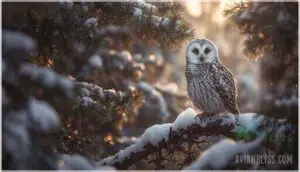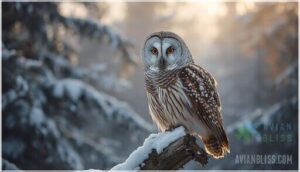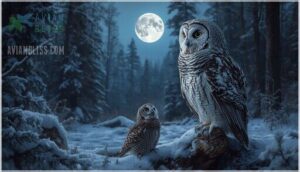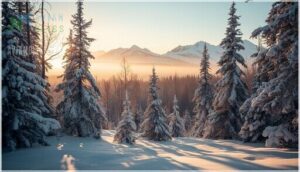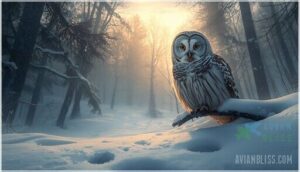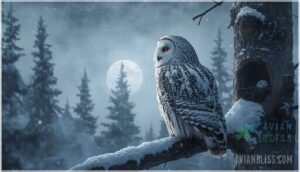This site is supported by our readers. We may earn a commission, at no cost to you, if you purchase through links.
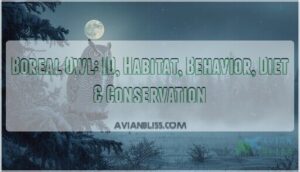
You’ll find them perched motionless in spruce forests spanning 12,000 kilometers, from Alaska to Siberia, their yellow eyes locked on prey invisible to most predators. Their survival hinges on acoustic precision, feathered legs that trap heat, and wings engineered for silent flight through dense timber.
Understanding how they hunt, breed, and adapt reveals why these owls matter to boreal ecosystems teetering on the edge of climate disruption.
Table Of Contents
- Key Takeaways
- Boreal Owl Identification and Features
- Boreal Owl Habitat and Range
- Boreal Owl Behavior and Lifestyle
- Boreal Owl Diet and Ecological Role
- Boreal Owl Breeding and Conservation
- Frequently Asked Questions (FAQs)
- How do you identify a Boreal Owl?
- What is the difference between a saw whet owl and a Boreal Owl?
- What is the difference between a pygmy owl and a Boreal Owl?
- What sounds like a Boreal Owl?
- How do Boreal Owls interact with other owls?
- What adaptations help Boreal Owls survive in winter?
- How does lighting affect Boreal Owl activity?
- Are there cultural significances of Boreal Owls in different regions?
- What role does the Boreal Owl play in folklore?
- What sounds do Boreal Owls make?
- Conclusion
Key Takeaways
- Boreal Owls survive in extreme cold through specialized adaptations including asymmetrically placed ears that pinpoint prey beneath 30 cm of snow, completely feathered legs that reduce heat loss by 25%, and silent flight mechanisms that cut aerodynamic noise by 18%.
- These owls play a critical role in controlling rodent populations by consuming over 60% voles in their diet, removing 10-12 kg of small mammals annually per owl, which dampens rodent population explosions by 15-20% and increases seedling survival by up to 15%.
- Climate change poses an existential threat to Boreal Owl populations, with projections showing an 85% decline in suitable habitat by 2090 and complete loss of breeding areas in southern ranges like New Mexico due to rising temperatures disrupting prey cycles and fragmenting forest ecosystems.
- The species exhibits North America’s most extreme sexual dimorphism among owls, with females weighing 60% more than males (132-215g vs 93-139g), and breeding success fluctuates dramatically with vole abundance cycles that directly influence clutch size and fledgling survival rates.
Boreal Owl Identification and Features
You’ll find the Boreal Owl easier to identify once you know what sets it apart. This small, stocky owl has features that distinguish it from similar species in its northern range.
Let’s look at the key physical traits, plumage patterns, age variations, and how it compares to other owls you might encounter.
Physical Characteristics and Measurements
You’ll notice the Boreal Owl’s stocky build right away. Males measure 21-25 cm and weigh 93-139 g, while females reach 25-28 cm and tip the scales at 132-215 g—the most extreme sexual dimorphism among North American owls. Their wingspan stretches 55-62 cm, with broad, rounded wings built for silent flight through dense forest.
The large square head and completely feathered legs aren’t just for show—they’re survival tools in sub-zero temperatures. They’re often found in mature spruce forests.
Distinctive Facial Features and Plumage
Look closely at the Boreal Owl’s gray face—that pale facial disc, framed by a stark black border, works like a sound funnel. The yellow eyes and light beak stand out against this disc, while white spots pepper the olive-brown crown.
Feather acoustics matter here: the disc channels sound to asymmetrically placed ears, letting you detect voles under 30 cm of snow.
Upper plumage shows umber-brown with large white spots; underparts are streaked cream and rust for camouflage. They thrive in dense coniferous forests.
Sex and Age Differences
Sexual Dimorphism runs deep in Boreal Owls—females weigh 132–215 g, males only 93–139 g, a 60% difference that’s North America’s most extreme among owls. Females also measure longer tarsi (23.1 mm versus 20.7 mm), supporting incubation stability.
Juvenile plumage starts chocolate-brown at fledging, then molts to mottled brown-and-white by two months. Both sexes reach reproductive maturity around nine months.
Molt timing differs: females replace feathers a month earlier than males, while sex ratios in broods shift with prey abundance—more males emerge in high-vole years.
Comparison to Similar Owl Species
You’ll need more than size to sort out small owls—Northern Saw-whet Owls have black bills versus your subject’s yellow, plus pale faces without spotted foreheads.
Northern Pygmy Owls hunt by day with long, barred tails and false eye-spots on their napes.
Western Screech-Owls carry ear tufts and crisp horizontal barring.
Great Gray Owls dwarf Boreal Owls at 60–84 cm, while Barred Owls show dark eyes and vertical chest streaking—traits you won’t find on Tengmalm’s Owl (Richardson’s Owl in North America).
Boreal Owl Habitat and Range
You’ll find Boreal Owls across the northern forests of North America and Eurasia, where they’ve carved out a niche in some of the planet’s coldest woodlands. Their range tells a story of adaptation to high-altitude and high-latitude ecosystems.
Here’s where these owls make their home and how their habitat is shifting.
Geographic Distribution in North America and Eurasia
You’ll find boreal owls across a vast circumpolar distribution spanning Alaska through Canada to Scandinavia and Siberia—nearly 12,000 km of boreal forests. In North America, breeding populations stretch from Alaska eastward across Canada, with isolated southern populations in the Rockies reaching northern New Mexico. Eurasian range extends from Scandinavia through Russia to Sakhalin Island.
Habitat fragmentation creates geographic isolation in mountain systems, where population dynamics fluctuate with prey cycles. Range expansion remains limited by temperature gradients and forest availability.
Preferred Forest Types and Elevation
You’ll spot boreal owls in mature coniferous forests and mixed stands between 1,292 and 3,200 m elevation—higher at southern latitudes. Habitat preferences reflect microhabitat selection driven by forest structure and prey abundance:
- Spruce-fir forests account for 45% of documented breeding sites in western US national forests
- Mixed conifer-deciduous stands provide 40% of nest sites in central Idaho
- Old-growth forests with complex structure consistently support nesting populations
- Upland mixed forests dominate breeding habitat in Minnesota and Alaska
These boreal forest ecosystems supply the large-diameter trees and open understory essential for cavity nesting.
Effects of Climate Change on Habitat
Climate change threatens boreal owl populations through habitat loss and species displacement. By 2090, you’ll see an 85% decline in suitable habitat under warming scenarios—southern populations in New Mexico may lose 100% of breeding areas.
Forest degradation from insect outbreaks and increased fire frequency compounds habitat fragmentation. Rising temperatures disrupt prey cycles, reducing vole abundance by 60% during mild winters.
Elevation migration pushes habitat boundaries upward 200–400 meters, but forest ecosystem shifts can’t keep pace, creating gaps between existing and emerging suitable areas.
Boreal Owl Behavior and Lifestyle
The Boreal Owl lives life on its own terms, hunting under cover of darkness and thriving in harsh northern forests.
You’ll find this small predator has evolved exceptional ways to survive where most birds can’t. Let’s look at how these owls hunt, adapt, and claim their territory.
Nocturnal Hunting Strategies
Boreal owls are nocturnal hunters with exceptional sound localization abilities. They can detect prey beneath 20–30 cm of snow using asymmetrical ear openings that pinpoint location within 1–2° accuracy.
These nocturnal birds of prey rely on three critical hunting tactics:
- Sit-and-wait perching for 70–85% of hunting time, watching and listening from 2–6 meter heights before silent strikes
- Bimodal activity peaks within two hours post-sunset and 90 minutes pre-sunrise, when prey detection reaches maximum efficiency
- Acoustic adaptations including facial disc sound amplification and specialized feather fringes reducing flight noise by 75%
Their night vision and prey detection systems deliver 49–61% capture success rates per attempt.
Adaptations for Snow and Dense Forests
You can’t hunt in deep snow without serious cold-weather gear. The boreal owl’s thermoregulation system maintains a 39°C body temperature in −30°C conditions using leg plumage that cuts heat loss by 25%.
The boreal owl’s leg plumage cuts heat loss by 25%, maintaining a 39°C body temperature in −30°C conditions
Its 17,000-feather coat traps insulating air while specialized fringes reduce flight noise by 95% through dense forests. That white facial disc acts as a sound funnel in coniferous forests, amplifying prey detection under snow.
These nocturnal habits demand lightweight bones and low wing loading for maneuvering tight spaces.
Territorial and Roosting Habits
Males defend territories averaging several hundred hectares, broadcasting their presence through calls that echo across 10 square kilometers. Territory size and home range shift with vole populations—when prey drops, owls wander farther than usual. That restless movement links directly to their roosting behavior:
- They switch roost trees daily, moving 700–1,200 meters between consecutive perches
- Black spruce dominates roost choice (73% selection rate in conifer-heavy stands)
- Males show stronger Site Fidelity than dispersive females and juveniles
- Vocalization Patterns peak during breeding season, with detection rates hitting 35–52%
These nocturnal habits keep Boreal Owls solitary even when paired, meeting only at nest cavities.
Boreal Owl Diet and Ecological Role
The Boreal Owl’s diet reveals how this predator survives in harsh northern forests. Understanding what they eat and how they hunt shows their critical role in forest ecosystems.
You’ll find that these owls rely on specific prey and hunting methods to meet their energy needs.
Primary Food Sources and Prey
Small mammals form the backbone of the Boreal Owl’s diet. Voles dominate prey selection, especially red-backed voles, which can account for nearly half of total prey biomass in some regions. Shrews, mice, and small squirrels round out this nocturnal predator’s menu.
Birds like juncos and thrushes appear occasionally, contributing around 6% of dietary biomass. This food chain connection places the owl as a key player in predator-prey dynamics, directly influencing rodent populations across boreal forests.
Hunting and Foraging Techniques
You’ll see this nocturnal predator perching motionless beneath conifer canopies, waiting for the faintest rustle below. Acoustic adaptations—asymmetrical ears offset by over 10 millimeters—let you triangulate prey sounds through 25 centimeters of snow. Silent flight, achieved through specialized wing feathers, carries you into snow-plunging strikes at 4.2 meters per second. This sit-and-wait approach conserves energy while maintaining over 70% ambush success within 10 meters of each perch.
- Nocturnal hunting peaks between 20:00–04:00 hours, with over 90% of foraging activity concentrated in total darkness
- Prey detection relies on acoustic triangulation, amplified by facial disks that boost sound localization precision by 20%
- Silent flight mechanisms reduce aerodynamic noise by 18%, enabling undetected descents onto unsuspecting small mammals
- Snow-plunging attacks penetrate powder layers up to 20 centimeters deep, targeting voles moving beneath the surface
- Perch intervals span 85% of active foraging time, with owls shifting locations every 10–30 meters to refine prey detection zones
Role in Small Mammal Population Control
This nocturnal hunter shapes ecosystem balance through predator-prey dynamics that stabilize rodent regulation cycles. Over 60% of their diet consists of voles, directly influencing small mammal population control and triggering trophic cascades that affect forest ecosystems. Population fluctuations of prey animals sync with owl breeding success, creating regulatory feedback that dampens rodent explosions by 15–20% across boreal zones.
| Ecological Impact | Measured Effect |
|---|---|
| Vole population reduction | 40% rebound when owls removed |
| Small mammal removal rate | 10–12 kg per owl annually |
| Breeding density response | 0.2 to 0.8 pairs/km² during prey peaks |
| Seedling survival increase | Up to 15% from reduced herbivory |
| Rodent cycle amplitude damping | 15–20% stabilization regionally |
Boreal Owl Breeding and Conservation
Boreal Owls follow flexible breeding patterns that shift with food availability.
Their nesting habits, reproductive cycles, and conservation challenges reveal how these northern hunters adapt to changing conditions.
Here’s what you need to know about their breeding biology and current status.
Mating and Nesting Habits
Courtship rituals begin in late winter when you’ll hear males producing whistled calls from perches near potential nest sites. During pair bonding, males feed females for up to three months before nesting occurs.
Here’s what nest site selection involves for these owls:
- Males present up to five cavity options to their mates
- Females choose woodpecker holes or natural hollows with 5–7 cm entrances
- Nests are usually 3–10 meters above ground in mature trees
- Artificial nest boxes see over 60% occupancy rates near forest edges
- Site fidelity brings 45% of females back to previous nesting locations
Egg incubation lasts 26–32 days while males deliver prey throughout. Boreal owl nesting habits reflect tight synchronization with prey cycles, with clutch sizes ranging from three to nine eggs depending on vole abundance.
Reproductive Cycle and Fledgling Care
Egg incubation spans 26–32 days, with females handling all warming duties while males deliver fresh prey. Nestling growth is rapid—eyes open around day 10, and young fledge between 27 and 36 days after hatching.
Parental care continues for up to seven weeks post-fledging as adults feed juveniles until independence arrives. Breeding success hinges on vole abundance, directly influencing clutch size and fledgling survival rates across nesting seasons.
Conservation Status and Threats
Classified as Least Concern by IUCN, this species still faces regional threats. Climate change threatens to reduce suitable habitat by up to 85% in southern ranges by 2090. Habitat loss from logging removes critical nest sites, while human impact through forest fragmentation decreases breeding density by 25%.
Key conservation efforts include:
- Nest box programs achieving 40% occupancy rates in Scandinavia
- Habitat restoration targeting 200,000 hectares of mature conifer forest by 2030
- Acoustic monitoring networks tracking population decline across 500+ survey sites
Climate shifts disrupt prey cycles, threatening populations at habitat edges where warming drives local extinctions.
Frequently Asked Questions (FAQs)
How do you identify a Boreal Owl?
You might think spotting an owl in dense forest is impossible, but the Boreal Owl’s signature look breaks through the darkness.
Look for a grayish-white facial disc with a bold dark rim, bright yellow eyes, and white spots scattered across brown plumage—your unmistakable field marks.
What is the difference between a saw whet owl and a Boreal Owl?
You’ll notice the Boreal Owl is larger and grayer with a distinctive yellow bill and black-rimmed facial disc, while the Northern Saw-whet Owl is smaller with a dark bill and diffuse buff-brown face without sharp borders.
What is the difference between a pygmy owl and a Boreal Owl?
Think of the Pygmy Owl as the day-shift hunter, while the Boreal Owl works the night.
Pygmy Owls are smaller, diurnal birds hunting during daylight in varied forests. Boreal Owls are larger, nocturnal specialists in dense boreal forests with distinct facial discs for sound detection.
What sounds like a Boreal Owl?
Several bird and animal species produce sounds similar to Boreal Owl vocalizations. Northern Saw-whet Owls emit rapid, high-pitched whistles that resemble the fast tooting song of Boreal Owls.
Mourning Doves produce low cooing sounds often mistaken for owl calls during nocturnal hours, especially in dense forests where acoustic analysis becomes challenging.
How do Boreal Owls interact with other owls?
Like a territorial chess match on silent wings, owls compete fiercely with one another. You’ll find Boreal Owls facing predation from Great Horned Owls, battling for nesting cavities with Barred Owls, and overlapping hunting territories with Eurasian Pygmy Owls—dynamics shaped by nocturnal bird of prey social hierarchy.
What adaptations help Boreal Owls survive in winter?
You’ll rely on dense, waterproof feathers that trap air for insulation and increased subcutaneous fat reserves for energy during harsh conditions.
Behavioral flexibility includes torpor, nomadic movements tracking prey, and acoustic hunting beneath snow cover.
How does lighting affect Boreal Owl activity?
Lighting dramatically reshapes nocturnal bird behavior in ways you’d never expect. Artificial light pollution disrupts your Boreal Owl’s hunting patterns and reduces foraging activity near bright sources. These nocturnal adaptations—including remarkable visual acuity and circadian rhythms tied to darkness—become compromised when light pollution invades Boreal Owl habitat and range, affecting owl behavior across their northern territories.
Lunar cycles influence vocal displays, with increased moonlight boosting call frequency while also raising predation risk.
Are there cultural significances of Boreal Owls in different regions?
Indigenous communities across North America revered Boreal Owls as spiritual messengers and wisdom symbols. Cree traditions viewed their calls as summons from the spirit world.
European folklore linked owls to death omens, while Siberian cultures saw them as shamanic guides embodying insight and protection.
What role does the Boreal Owl play in folklore?
In folklore, the owl has never been just a bird—it walks the line between wisdom and warning. Boreal Owls carry spiritual guidance in Native beliefs, especially among the Cree, who hear spirit messages in their calls.
Cultural symbolism varies: some traditions see them as protectors tied to mythical associations of knowledge, while others link them to death omens in folklore legends.
What sounds do Boreal Owls make?
Males produce 8 to 20 low, whistled toots during breeding season—these owl calls range from 550 to 950 Hz and increase in volume. Females respond with softer, high-pitched whistles.
Juveniles emit harsh peeps around 4 kHz when hungry.
These nocturnal sounds peak from mid-February through April.
Conclusion
The boreal owl doesn’t adapt to its frozen world—it masters it. Like a watchmaker dissecting clockwork, this predator deconstructs darkness with ears that measure distance to the millimeter. Yellow eyes, feathered legs, and serrated wings solve problems most raptors can’t touch.
But warming winters now fragment their spruce strongholds, pushing populations toward higher elevations where prey grows scarce. Your understanding of this owl’s mechanics matters because boreal forests won’t wait for consensus—they’re already changing.
- https://www.allaboutbirds.org/guide/Boreal_Owl/lifehistory
- https://ootadoussac.ca/en/programmes/boreal-and-northern-saw-whet-owl-monitoring/
- https://www.nature.com/articles/s41598-020-77531-y
- https://wtip.org/owl-irruption-winds-down-tracking-population-trends-in-superior-national-forest/
- https://animaldiversity.org/accounts/Aegolius_funereus/

